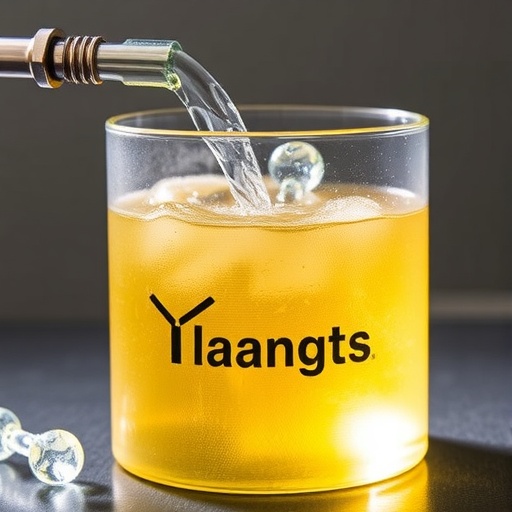In a world where access to clean drinking water remains one of the most critical challenges, particularly in resource-constrained and disaster-stricken areas, groundbreaking innovations are urgently needed. Recently, researchers have unveiled a novel self-floating photocatalytic film that demonstrates unprecedented efficiency in disinfecting highly contaminated water under low natural sunlight conditions. This development promises to revolutionize water purification strategies, especially in regions where conventional methods fall short due to limited infrastructure or energy resources.
Traditional photocatalysts, such as titanium dioxide (TiO₂) and graphitic carbon nitride (g-C₃N₄), have long been studied for their ability to harness light energy to neutralize pathogens and degrade pollutants. However, their performance is often severely hampered under low light intensities common in many parts of the world. Weak illumination restricts the generation of reactive oxygen species (ROS), which are pivotal to the disinfection process. Consequently, practical applications of these materials in real-world, low-light environments have been limited, posing a significant barrier to widespread adoption.
The innovation presented in this new study transcends these limitations by leveraging an unconventional class of reactive species—oxygen-centered organic radicals. Unlike commonly known ROS such as hydroxyl radicals and superoxide anions, these oxygen-centered organic radicals exhibit ultralong lifetimes, enduring several orders of magnitude longer than typical ROS. This extraordinary persistence allows them to accumulate even in low photon environments, resulting in sustained disinfection activity that was previously unattainable with existing photocatalysts.
One of the distinguishing features of this self-floating photocatalytic film is its ability to treat large volumes of water efficiently. The researchers demonstrated a greater than 4.3-log reduction in bacterial populations within 40 minutes in 10 liters of highly contaminated water under natural sunlight intensities as low as 13 to 18 milliwatts per square centimeter. Such performance is remarkable given the low photon input and the high contamination levels, revealing the film’s potential for real-life deployment in challenging settings.
The floating nature of the film plays a crucial role in its effectiveness. By remaining on the water’s surface, the film maximizes its exposure to sunlight, unlike submerged photocatalysts that suffer from light attenuation through the water column. This strategic positioning ensures optimal photon absorption and ROS generation, directly translating into superior disinfection rates.
Moreover, the film’s design promotes reusability and stability. Oxygen-centered organic radicals specifically avoid attacking the photocatalyst material itself, mitigating degradation issues that often plague photocatalytic systems. As a result, this film can be reused at least 50 times without significant loss of activity, establishing its economic and environmental sustainability advantages.
From a mechanistic perspective, the generation of oxygen-centered organic radicals stems from the intricate interplay between the film’s composition and the incident light. Upon illumination, the material facilitates the transfer of photogenerated charges to oxygen molecules and organic moieties, giving rise to these persistent radical species. Their robustness against rapid recombination or self-destruction contrasts starkly with classical ROS pathways, thereby creating a steady-state population capable of continuous microbial inactivation.
The implications of harnessing such radicals extend beyond simple water disinfection. Their longevity and selective reactivity potentially open new avenues for environmental remediation, pathogen control, and even medical sterilization processes where prolonged ROS action is desirable without collateral damage to the catalyst or surrounding materials.
Importantly, this technology aligns perfectly with the needs of underserved communities. Its operation under natural sunlight eliminates reliance on complex power supplies or chemical additives. The low energy demand and ease of deployment mean that even disaster-affected or remote regions with scarce infrastructure could implement this system effectively to ensure microbial safety in drinking water.
The research team underscored the scalability of the film, envisaging future iterations with enhanced surface areas and modular configurations suitable for varying water treatment volumes. Integration into existing water systems or portable filtration units could facilitate immediate impact, providing a practical solution to persistent waterborne diseases prevalent across the globe.
Furthermore, the film’s robustness suggests minimal maintenance and operational costs, crucial factors often limiting the deployment of advanced water treatment technologies in lower-income settings. Its resilience to fouling and environmental stress further enhances its applicability in diverse climatic and geographic conditions.
This pioneering work represents a significant leap forward in photocatalysis-driven water disinfection. By identifying and exploiting the unique characteristics of oxygen-centered organic radicals, researchers have unlocked a pathway to high-efficiency microbial inactivation under conditions previously thought inhospitable to photocatalytic techniques.
Future studies are anticipated to dissect the exact molecular pathways underpinning radical formation and to optimize the film’s material composition for even greater performance metrics. Expanding the range of target microorganisms and pollutants is also likely, aiming to establish this technology as a universal water treatment modality.
In a broader context, this achievement epitomizes the convergence of material science, chemistry, and environmental engineering to tackle one of humanity’s most pressing challenges—safe drinking water access. The synergy of innovative radical chemistry and practical design underscores the transformative potential of photocatalytic technologies in sustainable development.
In conclusion, the advent of this self-floating photocatalytic film redefines water disinfection paradigms by combining ultralong-lived reactive species, strategic material architecture, and renewable solar energy. It offers hope for millions worldwide who currently lack reliable sources of safe water, promising a future where clean water is a reality, not a privilege.
Subject of Research: Development of a self-floating photocatalytic film for efficient microbial inactivation in contaminated water under low natural sunlight.
Article Title: Reusable photocatalytic film for efficient water disinfection under low light intensity.
Article References:
Huang, Y., Li, X., Yan, H. et al. Reusable photocatalytic film for efficient water disinfection under low light intensity. Nat Water (2025). https://doi.org/10.1038/s44221-025-00500-0
Image Credits: AI Generated




